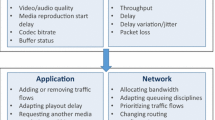Abstract
Advances in Internet Protocol (IP) multicasting provide a rich background for support of IP multipoint collaborative communications. IP multicast applications have traditionally been deployed over wired networks, however, new wireless technologies such as Local Multipoint Distribution Service (LMDS) are currently emerging as transport mechanisms for wireless video, voice, and application sharing environments. For multimedia wireless services to effectively evolve, management tools that can support Quality of Service (QoS) adaptation of increasingly complex network resources and customer application profiles are needed. In this paper, we present a control model which provides response time and bandwidth requirement adaptation of audio, video, and application sharing multipoint IP teleconferences for emerging wireless multimedia communications. Our study is innovative in that it integrates feedback controls between the application and network layers. Our model is based on revealing feedback controls for multimedia call preparation and subsequent real-time connection control. Case-based reasoning memory is used to match real-time congestion (connection) controls with call preparation controls and user profiles for improved QoS. Network agents are used to capture user and multimedia teleconference application call profiles at the application layer and transfer them to the case memory. Real Time Protocol (RTP) statistics are used to identify connection management feedback controls at the network layer. Receiver-based, real-time adaptation at the network layer and above is possible through the use of a hierarchical coding technique. The proposed adaptive management architecture is based upon a case memory representation of call preparation feedback controls, RTP feedback controls for providing audio stream bandwidth adaptation, and configuration descriptions for integrated experiments. We conclude that implementation of these techniques should lead to improved QoS of wireless IP multipoint teleconferences.
Similar content being viewed by others
Explore related subjects
Discover the latest articles, news and stories from top researchers in related subjects.References
S. Aidarous and T. Plevyak, Telecommunication Network Management into the 21st Century (IEEE Press, New York, 1995).
J. Bolot and T. Turletti, Experience with control mechanisms for packet video in the Internet, ACM Computer Communication Review (January 1998).
A. Bordetsky, Reasoning on infeasibility in distributed collaborative computing environment, Annals of Mathematics and Artificial Intelligence 17 (1996) 155-176.
A. Bordetsky and E. Bourakov, Agents-facilitators for adaptive management of collaborative environments, in: Proceedings of the 3rd INFORMS Conference on Information Systems and Technology, Montreal (26-28 April 1998) pp. 82-96.
I. Busse, B. Deffner and H. Schulzrinne, Dynamic QoS control of multimedia applications based on RTP, in: International Workshop on High-Speed Networks and Open Distributed Platforms (1995).
M.R. Genesereth and S. Ketchpel, Software agents, Communications of the ACM 37(7) (1994).
V. Hardman, M. Sasse and I. Kouvelas, Successful multiparty audio communication over the Internet, Communications of ACM 41(5) (May 1998).
D. Hoffman and M. Speer, Hierarchical video distribution over Internet-style networks, in: Proceedings of the IEEE International Conference on Image Processing, Luasanne, Switzerland (September 1996).
I. Kouvelas, V. Hardman and J. Crowcroft, Network adaptive continuous-media applications through self organized transcoding, in: Proceedings of Network and Operating Systems Support for Digital Audio and Video (NOSSDAV '98), Cambridge, UK (8-10 July 1998).
L. Lewis, Managing Computer Networks: A Case-Based Reasoning Approach (Artech House, Norwood, MA, 1995).
T. Malone and K. Crowston, The interdisciplinary study of coordination, ACM Computing Surveys 6(1) (1994) 87-119.
G. Marakas, Decision Support Systems in the Twenty-First Century (Prentice-Hall, New York, 1998).
J. Mayfield, Y. Labrou and T. Finin, Desiderata for agent communication languages, in: Proceedings of the AAAI Symposium on Information Gathering from Heterogeneous, Distributed Environments, AAAI-95 Spring Symposium, Stanford University, Stanford, CA (27-29 March 1995).
S. McCanne, V. Jacobson and V. Vetterli, Receiver-driven layered multicast, in: Proceedings of ACM SIGCOMM, Stanford, CA (August 1996).
C. Parris, G. Ventre and H. Zhang, Graceful adaptation of guaranteed performance service connections, in: Proceedings of IEEE GLOBECOM '93, Houston, TX (November 1993).
H. Schulzrinne, S. Casner, R. Frederick and V. Jacobsen, RTP: a transport protocol for real-time applications, RFC 1889 (January 1996).
Author information
Authors and Affiliations
Rights and permissions
About this article
Cite this article
Bordetsky, A., Brown, K. & Christianson, L. A Feedback Control Model for Managing Quality of Service in Multimedia Communications. Telecommunication Systems 17, 349–371 (2001). https://doi.org/10.1023/A:1016623808159
Issue Date:
DOI: https://doi.org/10.1023/A:1016623808159




